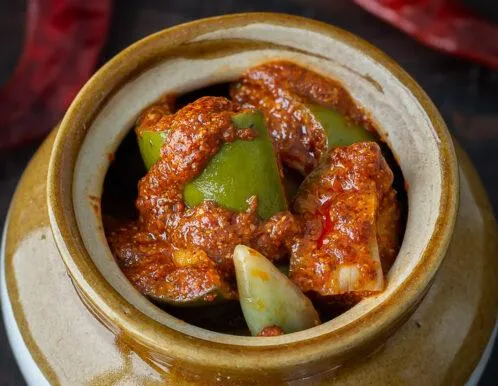The forgotten jar: why pickle no longer sits at our table
Preserving culinary heritage

The traditional jar of mango pickle is fast disappearing, says the writer.
Image: Supplied
JUST north of Durban lies KZN’s Gucci Coastline where luxury lounges on the very soil once soaked with the sweat and sacrifice of Indian indentured labourers, who didn’t come for beachside cocktails but to break their backs in sugar cane fields.
Here we find the bedroom communities of Umhlanga, Izinga, Brettenwood, Zululami Sibaya, Ballito, and a well-manicured handful of other similar areas. I say “bedroom” because the majority of residents sleep here but commute elsewhere for work. Now this is the Moët & Chandon Crescent where the bubbles flow and the bills never stop; the Range Rover Riviera where every pothole, ignored by the municipal roads department, is dodged in style; and the Botox Bay Area where smooth waves mean smoother foreheads.
Nestled in these prestigious precincts are haute cuisine sanctuaries that cater to the discerning palates of the well-heeled and worldly with an opulent blend of artistry and flavour.
The air in these restaurants is seasoned with ego and there are some who dine there, not for the food, but for the chance to be seen chewing in R10 000 outfits. The menus boast a symphony of seasonal ingredients and avant-garde technique. Flaky pastry filled with truffle-scented mushrooms and goat cheese; grilled asparagus with miso hollandaise; duck breast with blackberry reduction; rich shellfish broth with cognac, cream, and lobster medallions; and lamb loin with pistachio crust. Just some of the meals curated by Michelin-starred chefs.
Meanwhile, on the dining table of a modest house in another area north of Durban - Phoenix, Verulam or Tongaat - there sits a steaming plate of fluffy rice, gently soaked in golden dhal and accompanied by red potato curry. Something is missing. Then a spoonful of mango pickle is added on the side. Suddenly, the dish sings and moves to another level, outshining the pomp of a plush restaurant’s finest fare.
The humble pickle’s tangy punch, infused with mustard seeds, fenugreek, chili and oil, cuts through the mellow richness of the dhal. Each mouthful becomes a dance of flavours - sour, salty and fiery - all at once. Yes, dhal and rice is soul food. But with mango pickle? It’s soul food with swagger.
Foodie Jimmy Moodley will concur – he’d rather starve than have a meal without some kind of pickle. Indian meals often rely on balance - sweet, sour, salty, bitter, and spicy. This is clearly reflected in the South Indian thali meal that features staples like rice and lentils, various vegetable curries, rasam, sambar, yoghurt, chutneys, and a sweet dish. Also included on the banana leaf or steel plate is pickle, which introduces contrast that makes each component pop.
Sadly, pickle jars are hardly seen in the kitchen pantry nowadays. There was a time not too long ago when sliced and salted green mangoes drying, curling and fermenting in the sun, were a common sight in many Indian homes across the country. I, like many children then, would nick a few pieces before bottling time. Once yearly my mother would painstakingly perform the ritual of making mango pickle. Sometimes she would make lemon, lime, kumquat and even loquat pickle.
Those days pickle-making wasn’t just a kitchen task. It was an event. Aunties would gather, armed with knives, spices, and stories. And when the jars were finally sealed, they weren’t just filled with achar - they were filled with memory. But today, those jars are fewer. And so are the mango trees.
Urban development has crept into spaces once reserved for gardens. Mango trees have been replaced by driveways, lemon trees by security walls. The lime tree that once stood proudly in the corner of the yard is now a distant memory. With fewer fruit-bearing trees, the raw ingredients for homemade pickle have become scarce. Even the climate seems to have shifted.
Rainfall patterns are unpredictable, and the fruit yields are no longer what they used to be. I must add though that judging by the number of green mango vendors along Sparks Road and Brickfield Road in Overport, Durban, the yield of mangoes this season mangoes seem to be more plentiful than in previous years. But this will not translate into more mango pickle.
Pickle-making at home is a dying art. Migration and assimilation into broader society has meant letting go of certain practices. Pickle-making, once a communal ritual, has become less central to identity and daily life. Pakco, the Verulam-based food manufacturing company, used to be famous for its mango pickle but this line has been discontinued. It is believed the non-availability in large quantity of the Natal round variety of mangoes that is suited for pickle is to blame.
Younger generations, raised on fast food and global flavours, often don’t see pickle as essential. It’s no longer the proud obligatory companion to curry and rice. Now its an optional extra, sometimes forgotten altogether. Homemade pickles require days of preparation, sun-drying, and careful storage. A modern lifestyle prioritises speed and convenience over craft. Thus, ready-made pickles from supermarkets are preferred by the shrinking number of pickle-lovers, never mind that they lack the soul of the homemade versions.
In days gone by, recipes and techniques were passed down orally, often from grandmothers. As younger generations moved away or adopted different lifestyles, this culinary wisdom wasn’t always preserved. And since traditional pickle consumption has decreased, even the achar recipes in Zuleikha Mayat’s cookery book Indian Delights are hardly consulted.
Health trends have also made people wary of oil, salt, and spice. Salads have replaced the preference for intensely-flavoured, oily pickles. Western-style condiments like hummus, pesto, and sriracha are replacing traditional accompaniments at the table. There was a time when some pregnant women would crave for pickles. No more. Today’s expectant mothers might be reaching for avocado toast, pretzels or tinned fish samoosas.
Changing meal structures have also contributed to the diminishing popularity of pickles. Traditional Indian meals with rice, curry, and pickle are less common in fast-paced urban life. Quick meals from Woolies, Fishaways, Debonairs, KFC and Nandos leave no room for achar on the plate. The fading of pickles is not just about food. It’s about memory, identity, and the quiet loss of traditions rooted in the soil. A good pickle was never just a flavour enhancer; it was a connection to the land, to family, and to the rhythm of the seasons.
But perhaps it’s not too late to make pickles popular again and start a taste renaissance. We can plant again. Not just mango, lemon and lime trees, but traditions. Maybe the next time you pass a nursery, you’ll consider a mango sapling. Maybe you’ll ask your mother for her pickle recipe. Maybe, just maybe, you’ll gather your children and show them how to slice, spice, and seal a jar of memory.

Yogin Devan
Image: File
Yogin Devan is a media consultant and social commentator. Reach him on: [email protected]
** The views expressed do not necessarily reflect the views of IOL or Independent Media.